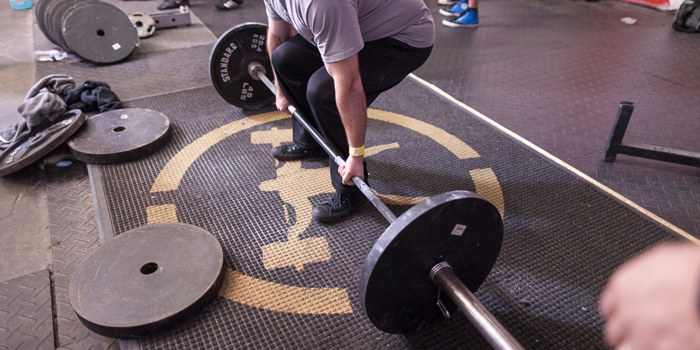
When I began training for my first strongman competition, I had a good base of strength from powerlifting but hadn't done a lot of training for muscular endurance on the deadlift (as is the case with most people). One of the events in the competition was a deadlift medley, where you deadlifted an axle, regular barbell, and then did max reps in a frame for the remainder of the 60 seconds. Sixty seconds may not sound like a lot of time, but if you're trying to get as many reps as possible, it can be easy to gas out quickly.
Initially, when I started training for this, I was picking a lower percentage of weight on the deadlift, trying to set records for how many reps I could do in 60 seconds. This setup was fine for a couple of weeks, but inevitably I hit a point of diminishing returns. It can burn you out or lead to injury if you aren't careful. That's the challenging part of deadlift reps in general. If your technique starts to unravel due to fatigue, injury can quickly follow.
RECENT: The Need for a Calm Leader in 2020
At that time, I had a key to a Crossfit gym and would do my training sessions there when there wasn't a class. I was talking to the owner of the gym one day about my competition coming up, and he suggested doing smaller sets broken up at the top of every minute (commonly known in the Crossfit world as EMOM workouts or every minute on the minute). I started to play around with different weights, rep schemes, and times for this, and it began to work well. I was able to build some really good muscular endurance and conditioning for the deadlift (in addition to the normal strength work I was doing). When the competition rolled around, I won that event, with 15 reps more than the next person behind me. I know for certain there were people with stronger deadlifts than me that I beat, and it was because I had trained my conditioning to accommodate the unique event. Even after that strongman competition, I decided to rotate these types of sets in as a way to keep my muscular endurance high for deadlifting (which I believe has been helpful for preventing injury) and improve my conditioning overall in a practical way. Whether it's for a strongman or Crossfit competition, or just for general fitness (in some ways I think this is actually the best benefit), I think these sets can be an excellent tool for deadlifts.
So how do you go about implementing these in your training? I think the most important thing is to make sure you swallow your pride and do not view the weights you use for these in the same way you view a regular deadlift. Rule of thumb, start lighter than you think you should. By the time you get through a few sets, you'll be happy you did. If at any point your technique starts to diminish to the point where you can't do the lift safely, you need to stop or go lighter. These have to be done submaximally to be done safely and effectively. Remember, the benefit in this is accumulating volume in a fatigued state, not in how heavy you go.
You also have the option of what type of deadlift you choose. When I was training for the car frame event, I used a trap bar because it more closely emulated the frame. Other times I have used a regular deadlift from the floor, and other times a block pull off of two- to three-inch blocks. There are different benefits to each, and I think rotating them can be helpful (just make sure you start at a new light weight for each). I've done these with the trap bar, off the floor, off blocks (separate waves for each), and it was a good rotation.

Vladislav Markin © 123rf.com
For each wave, I recommend starting with a weight that is 55-60 percent of your 1RM. You may need to go lighter or slightly heavier, but this is a good place to see how it feels. I would start with a rep range like five, and pick a number of sets you want to accomplish (say, eight sets). When you start your first set, you'll start your timer first, and complete five reps. Then you'll rest until you hit the top of the next minute (the 1:00 mark on the timer) and start your next set. You'll repeat this for eight sets (so 40 total reps), starting each set at the top of each minute mark. Make sure your technique and intensity is consistent across all sets. Treat each one as an individual set and as if it is heavier than it is. Speed is a big part of this, as well. You'll find that those rest periods get shorter the more sets you do.
I recommend using a notepad to tally your sets or you'll definitely lose count if you're anything like me. The first week might have seemed very easy, but remember this is just the first week in your first wave of this. The next week, increase the number of sets to nine (45 total reps), and the next week, increase to 10 sets (50 total reps). Remember, if at any point your technique becomes unsafe, you have to go lighter or deload for a week.
After you hit the 10-set mark with five reps, you have a couple of options to keep the progressive overload going. You can:
- Increase bar weight. I recommend small increments like 10 pounds—definitely no more than 10 percent of the previous bar weight.
- Increase reps per set. You could bump from five to six or eight reps.
- Increase the number of sets. I've personally found that if I can go beyond 12, I need to increase one of the other variables. Increase the number of sets to emphasize the amount of conditioning you want.
As with many conditioning challenges, I think you'll find that as the weeks go by you'll improve dramatically. It just takes discipline and focus as you strategically overload each week. I would say once you hit the six-week mark, you'll want to deload (do a basic 3x5 with your original weight) or take off from this method entirely for a few weeks. This is a tool that is best used in doses.
You'll also want to make sure these fit in with the rest of your training program. Where there's a push, there's a pull in training, and if you're already on the brink of overtraining and then add these in, it won't end well. Make sure you organize these in your training week (or even every other week) so that you have time to recover and don't risk injury or burnout.
As I said, deadlifting for timed reps isn't commonplace for the average strength athlete, but it can be a great physical and mental challenge that pays off in other aspects of your training. If you have questions or decide to give this a try, let me know in the comments below.











4 Comments